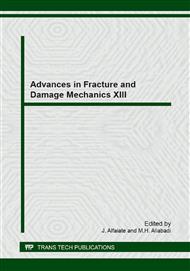p.405
p.409
p.413
p.417
p.421
p.425
p.429
p.433
p.437
Contact State Investigation of a Three-Point Bend Specimen Using Numerical Methods
Abstract:
At higher loading rates, modified Hopkinson pressure bar apparatus is widely used to determine the dynamic fracture toughness of the engineering materials. For accurate measurement of the dynamic fracture properties, we need to thoroughly understand the contact situation of the three-point bend specimen, with the loading apparatus. Strong inertial effects complicate the specimen’s contact situation with impactor and supports. In this work, ANSYS software is used for modeling and analysis of a modified Hopkinson pressure bar loaded fracture experimental setup. Analysis of stress contours and nodal displacements are used for the examination of specimen contact state. The results indicate that during loading in the elastic range, the specimen remains in contact with the loading apparatus as this is previously proved experimentally.
Info:
Periodical:
Pages:
421-424
Citation:
Online since:
September 2014
Authors:
Price:
Сopyright:
© 2015 Trans Tech Publications Ltd. All Rights Reserved
Share:
Citation:


